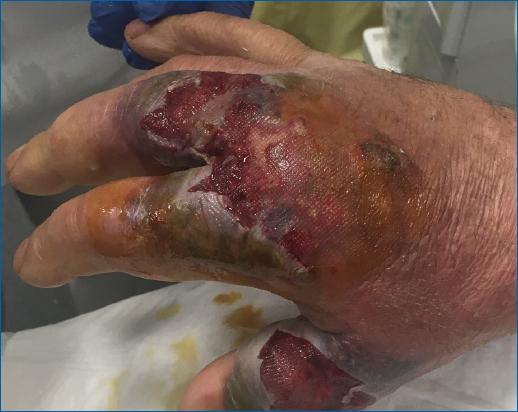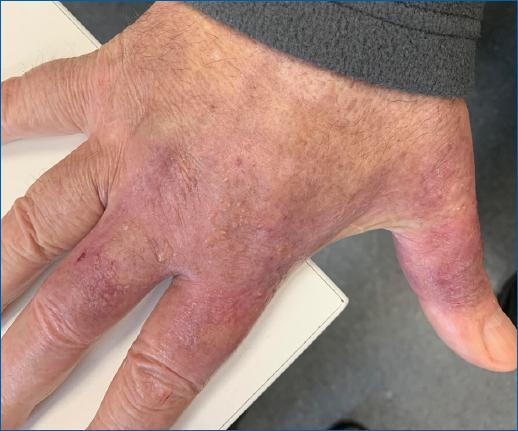Introduction
Neutrophilic dermatosis of the dorsal hands is a part of the heterogeneous group of neutrophilic dermatoses, considered to be a localized form of Sweet syndrome. It’s a rare dermatosis characterized by the sudden appearance of nodules or plaques on the dorsum of the hands, with a dense neutrophilic infiltrate on histology. About half of the cases are associated with hematologic problems.
Here we describe the case of a unilateral neutrophilic dermatosis of the dorsal hands associated with a myelodysplastic syndrome.
Clinical case
Our case focuses on a 60-year-old male patient, a farmer, with a previous diagnosis of myelodysplastic syndrome under regular surveillance at the haemato-oncology department, hemochromatosis, high blood pressure, hyperuricemia, and dyslipidemia.
He had also been previously followed in the Dermatology Department for presenting inflammatory plaques in the limbs 3 years ago. A skin biopsy performed at that time was compatible with leukocytoclastic vasculitis and Sweet syndrome. Lesions resolved with systemic corticotherapy and didn’t recur.
The patient presented to the emergency room with an ulcerated lesion on the dorsum of his left hand. This lesion had appeared 2 weeks before as two painful grayish nodules that rapidly proceeded to grow and ulcerate. He denied any history of trauma, itching, recent medication changes, or any other skin lesions.
At dermatological observation, the patient presented two moderately swollen, very painful ulcerated plaques on the dorsal aspect of the left hand with grayish borders and irregular margins (Fig. 1). Blood tests revealed a total leukocyte count of 13.2 x 109/L with 51% neutrophils and elevated C-reactive protein of 113 mg/L.

Figure 1 The patient presented to the emergency room with two moderately swollen, very painful ulcerated plaques on the dorsal aspect of the left hand.
A skin biopsy from the margin of the lesion showed mostly lobular panniculitis, and a dense neutrophilic dermal infiltrate, with no signs of leukocytoclastic or vasculitis. Cutaneous microbiologic cultures yielded negative findings.
Attending to his oncological and dermatological priors, the history and clinical hallmarks of the lesion, and the presence of a neutrophilic infiltrate in the skin biopsy, the diagnosis of a neutrophilic dermatosis of the dorsal hands was made.
The patient was treated with oral prednisolone 40 mg/day (0.5 mg/kg/day), with progressive tapering and colchicine 1 mg/day with quick improvement of the lesion and complete regression after 1 month (Fig. 2). No recurrence has been noted a year after.
Discussion
Neutrophilic dermatosis is a heterogeneous group of skin diseases characterized by dense infiltration of neutrophils in the affected tissue. Neutrophilic Dermatosis of Dorsal Hands is considered a localized variant of Sweet syndrome since the lesions clinically resemble those of sweet syndrome and show similar histologic evidence of a dense dermal neutrophilic infiltrate. In contrast to Sweet syndrome, however, the distribution is limited almost entirely to the dorsal hands1.
The etiology is unknown, but about half of the cases are associated with hematologic problems, as in this case, associated with myelodysplastic syndrome. In a review of 123 cases, the underlying disease was found in around 40% of patients, with the most common associations being hematological disorders (gammopathies, myelodysplasias, or malignancies)2.
Other case reports of this dermatosis were associated with sarcoidosis, hepatitis C, and bowel disorders. Some cases didn’t have any localized or systemic triggering factor3-6.
One unilateral case, as is this one, didn’t have any systemic association and occurred at the site of the insect bite, which suggests cutaneous pathergy is associated with this dermatosis7.
Clinically, this dermatosis presents as painful bluish or gray abscess-like nodules or plaque and blisters on the dorsal aspect of the hands, fingers, or wrists, most frequently in female and elderly patients. Rarely are the palms involved. These lesions may eventually ulcerate in 50% of the cases8, similar to the case described.
The diagnosis is clinical, but a skin biopsy is often performed for confirmation and will show similar histologic evidence of a dense dermal neutrophilic infiltrate as in Sweet syndrome9.
The differential diagnoses of this entity include localized cutaneous infection, pyoderma gangrenosum, and other neutrophilic dermatoses9.
Systemic corticosteroids are the treatment of choice for most cases, and response is usually fast. Given the frequency of relapse, the use of dapsone and colchicine is useful, as they also serve as steroid-sparing agents10.
Acknowledging the existence of this dermatosis is important since it may be misdiagnosed as a localized cutaneous infection, and a correct diagnosis should trigger a search for underlying diseases.















